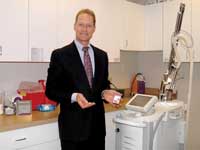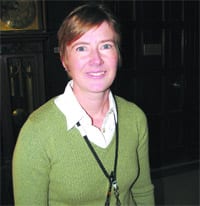CDH Recognized for Stroke Care
NORTHAMPTON — Cooley Dickinson Hospital recently received the American Stroke Association’s Get With the Guidelines–Stroke (GWTG-Stroke) Initial Performance Achievement Award. The award recognizes the hospital’s commitment to and success in implementing a higher standard of stroke care by ensuring that stroke patients receive treatment according to nationally accepted standards and recommendations.
“With a stroke, time lost is brain lost, and this award addresses the important element of time,” said Dr. Glenn Focht, senior vice president of Medical Affairs and chief medical officer at CDH.
Cooley Dickinson has developed a comprehensive system for rapid diagnosis and treatment of stroke patients admitted to its Emergency Department. This includes being equipped 24 hours a day, seven days a week to provide brain-imaging scans, having neurologists available to conduct patient evaluations, and using clot-busting medications when appropriate.
To receive the award, Cooley Dickinson consistently complied for 90 days with the requirements in the GWTG-Stroke program. These include aggressive use of medications like tPA, antithrombotics, anticoagulation therapy, DVT prophylaxis, cholesterol-reducing drugs, and smoking cessation. The 90-day evaluation period is the first in an ongoing self-evaluation by the hospital to continually reach the 85{06cf2b9696b159f874511d23dbc893eb1ac83014175ed30550cfff22781411e5} compliance level needed to sustain this award.
“The American Stroke Association commends Cooley Dickinson Hospital for its success in implementing standards of care and protocols,” said Dr. Lee H. Schwamm, national GWTG Steering Committee member and director of Acute Stroke Services at Massachusetts General Hospital in Boston. “The full implementation of acute care and secondary prevention recommendations and guidelines is a critical step in saving the lives and improving outcomes of stroke patients.”
“The time is right for Cooley Dickinson Hospital to be focused on improving the quality of stroke care by implementing GWTG-Stroke,” said Donna Truesdell, director of Quality Improvement at Cooley Dickinson. “The number of acute ischemic stroke patients eligible for treatment is expected to grow over the next decade due to increasing stroke incidence and a large, aging population.”
Each year, about 700,000 people suffer a stroke — 500,000 are first attacks, and 200,000 are recurrent. Of stroke survivors, 22{06cf2b9696b159f874511d23dbc893eb1ac83014175ed30550cfff22781411e5} of men and 25{06cf2b9696b159f874511d23dbc893eb1ac83014175ed30550cfff22781411e5} of women die within a year, and for those age 65 and older, the percentage is even higher. In 1999, $3.4 billion was paid to Medicare beneficiaries discharged from short-stay hospitals for stroke. Americans are estimated to pay about $56.8 billion in 2005 for stroke-related medical costs and disability.
For more information about Get With the Guidelines-Stroke, visitwww.strokeassociation.org/getwiththeguidelines.




Comments are closed.